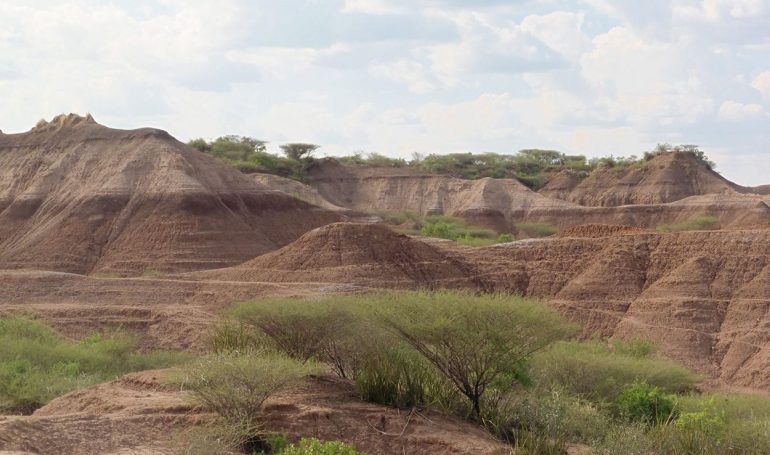Our species originated in Africa, but it is unclear when the first anatomically modern Homo sapiens arose there. Now a new dating of the oldest Homo sapiens fossil from East Africa provides new clues. The fossil found in the Omo-Kibish Formation in Ethiopia is therefore already at least 230,000 years old – and thus about 35,000 years older than previously thought. Unlike the older Homo sapiens fossils from Morocco, the human of Omo also has no archaic features. So he could have been one of the first truly modern representatives of our species.
Like many early human species, Homo sapiens evolved in Africa – that seems pretty obvious. However, where the first representatives of our species originated is largely unclear due to the paucity of fossils – so far only eight sites of remains of early Homo sapiens are known, many of them in East Africa. The once fertile East African Rift Valley in this region was therefore long considered the cradle of our species. Based on the age of the fossils, Homo sapiens originated about 200,000 years ago. In 2017, however, scientists in Morocco discovered fragments of a human skull that were already 300,000 years old and showed clear characteristics of Homo sapiens, even though some of the traits still appeared archaic. These findings, as well as complementary genetic studies, suggest that the roots of our species go back and forth – and may not just be in East Africa.
Volcano eruption as a dating aid
To gain more clarity, Celine Vidal from the University of Cambridge and her colleagues have taken another look at one of the oldest and best-known human fossils from East Africa. Fossil Omo 1 consists of parts of the skull of Homo sapiens that were found in the Omo Kibish Formation in southwest Ethiopia in the 1960s. The area was often characterized by volcanism, which is why the subsurface contains many layers of volcanic deposits and ash. “The fossils were discovered beneath a thick layer of volcanic ash, but using conventional radiometric methods no one could tell its exact date because the ash was so fine,” explains Vidal. Radiocarbon dating was also out of the question. However, from the dating of some larger parts and similarities with volcanic ejections, it was concluded at the time that the Omo 1 skull must be about 197,000 years old.
However, Vidal and his team once again examined the fossil’s location more closely and took new samples of ash atop the skull layer. In parallel, they also took samples from two volcanoes in the Ethiopian Rift System, Shala and Corbetti, which are known to have erupted several times between 250,000 and 170,000 years ago. To date the ash of the Omo Kibish, scientists have compared the geochemical characteristics of this ash layer with those of various older eruption remains. “Each eruption has its own fingerprint, which was shaped by the evolution and path of magma beneath the surface,” explains Vidal. By determining and comparing the chemical composition of the minerals contained in these volcanic materials, the team was able to more accurately determine the age of the ash layer in Omo Kibish for the first time.
32,000 years older than expected
The analyzes showed that the ash layer geochemically best corresponds to the eruption of the Shala volcano, about 400 km away. “But at first we didn’t know the exact age of this explosion,” Vidal explains. So they sent a sample of minerals from this volcanic material to colleagues who had done argon dating of the crystals. “When I got the results and learned that Homo sapiens fossils therefore must be older than I previously thought, I was thrilled!” Vidal says. Re-dating showed that Omo 1 is not 197,000 years old, but at least 230,000 years old. This means that the first appearance of Homo sapiens in East Africa has also been shifted to the past. Furthermore: “Unlike other fossils that were assigned to early stages of Homo sapiens evolution, Omo 1 undoubtedly has modern features, including a large, domed skull and a distinct chin,” said Aurelian, co-author of the Musée de l’ Mounier explains. Home in Paris. “New dating makes Omo 1 the oldest apparently anatomically modern Homo sapiens in Africa.”
As scientists point out, it cannot be denied that Homo sapiens evolved in East Africa much earlier. “We can only date the evolution of mankind from the fossils we have,” Vidal emphasizes. “That’s why it’s almost impossible to say: this is the definitive age of our species.” New discoveries and findings can change the previous timeline at any time.
Quayle: Céline Vidal (University of Cambridge, UK) et al., Nature, doi:10.1038/s41586-021-04275-8

Web guru. Amateur thinker. Unapologetic problem solver. Zombie expert. Hipster-friendly travel geek. Social mediaholic.





